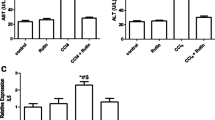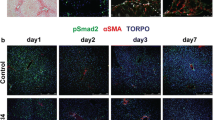Abstract
Purpose
Investigating the hepatoprotective effect of calycosin against acute liver injury in association with FXR activation and STAT3 phosphorylation.
Methods
The acute liver injury model was established by intraperitoneal injection of CCl4 in C57BL/6 mice. Serum alanine aminotransferase, aspartate aminotransferase, HE staining and TUNEL assay were used to identify the amelioration of the liver histopathological changes and hepatocytes apoptosis after calycosin treatment. ELISA kit and 5-bromo-2-deoxyuridine immunohistochemistry were used to measure the liver bile acid concentration and hepatocyte mitotic rate in vivo. The relation between calycosin and activation of FXR and STAT3 was comfirmed using the Luciferase assay, Molecular docking, Real-time PCR and Western Blot in vitro.
Results
The liver histopathological changes, hepatocytes apoptosis, liver bile acid overload and hepatocyte mitosis showed significant changes after calycosin treatment. Calycosin promoted the expression of FXR target genes such as FoxM1B and SHP but the effect was reversed by FXR suppressor guggulsterone. Molecular docking results indicated that calycosin could be embedded into the binding pocket of FXR, thereby increasing the expressions of STAT3 tyrosine phosphorylation and its target genes, Bcl-xl and SOCS3.
Conclusions
Calycosin plays a critical role in hepatoprotection against liver injury in association with FXR activation and STAT3 phosphorylation.






Similar content being viewed by others
Abbreviations
- ALT:
-
Alanine aminotransferase
- AST:
-
Aspartate aminotransferase
- BA:
-
Bile acid
- Bcl-xl:
-
B-cell lymphoma-extra large
- BSEP:
-
Bile salt export pump
- CNTF:
-
Ciliary neurotrophic factor
- CYP450:
-
Cytochrome P450
- CYP7A1:
-
Cytochrome P450 7A1
- FoxM1B:
-
Forkhead box M1B
- FXR:
-
Farmesoid X receptor
- LIF:
-
Leukemia inhibitory factor
- SHP:
-
Small heterodimer partner
- SOCS3:
-
Suppressor of cytokine signaling 3
- STAT3:
-
Signal transducer and activator of transcription 3
- TCMs:
-
Traditional Chinese medicines
References
Tirkey N, Pilkhwal S, Kuhad A, Chopra K. Hesperidin, a citrus bioflavonoid, decreases the oxidative stress produced by carbon tetrachloride in rat liver and kidney. BMC Pharmacol. 2005;5:2.
Lasser KE, Allen PD, Woolhandler SJ, Himmelstein DU, Wolfe SM, Bor DH. Timing of new black box warnings and withdrawals for prescription medications. JAMA. 2002;287:2215–20.
Thames G. Drug-induced liver injury: what you need to know. Gastroenterol Nurs. 2004;27:31–3.
Paine AJ. Heterogeneity of cytochrome P450 and its toxicological significance. Hum Exp Toxicol. 1995;14:1–7.
Williamsand AT, Burk RF. Carbon tetrachloride hepatotoxicity: an example of free radical-mediated injury. Semin Liver Dis. 1990;10:279–84.
Fiorucci S, Antonelli E, Rizzo G, Renga B, Mencarelli A, Riccardi L, et al. The nuclear receptor SHP mediates inhibition of hepatic stellate cells by FXR and protects against liver fibrosis. Gastroenterology. 2004;127:1497–512.
Vaquero J, Briz O, Herraez E, Muntane J, Marin JJ. Activation of the nuclear receptor FXR enhances hepatocyte chemoprotection and liver tumor chemoresistance against genotoxic compounds. Biochim Biophys Acta. 1833;2013:2212–9.
Meng Z, Wang Y, Wang L, Jin W, Liu N, Pan H, et al. FXR regulates liver repair after CCl4-induced toxic injury. Mol Endocrinol. 2010;24:886–97.
Chen WD, Wang YD, Zhang L, Shiah S, Wang M, Yang F, et al. Farnesoid X receptor alleviates age-related proliferation defects in regenerating mouse livers by activating forkhead box m1b transcription. Hepatology. 2010;51:953–62.
Huang W, Ma K, Zhang J, Qatanani M, Cuvillier J, Liu J, et al. Nuclear receptor-dependent bile acid signaling is required for normal liver regeneration. Science. 2006;312:233–6.
Liu Y, Binz J, Numerick MJ, Dennis S, Luo G, Desai B, et al. Hepatoprotection by the farnesoid X receptor agonist GW4064 in rat models of intra- and extrahepatic cholestasis. J Clin Invest. 2003;112:1678–87.
Howarth DL, Law SH, Law JM, Mondon JA, Kullman SW, Hinton DE. Exposure to the synthetic FXR agonist GW4064 causes alterations in gene expression and sublethal hepatotoxicity in eleutheroembryo medaka (Oryzias latipes). Toxicol Appl Pharmacol. 2010;243:111–21.
Gao B. Cytokines, STATs and liver disease. Cell Mol Immunol. 2005;2:92–100.
Sleeman MW, Anderson KD, Lambert PD, Yancopoulos GD, Wiegand SJ. The ciliary neurotrophic factor and its receptor. CNTFR Alpha Pharm Acta Helv. 2000;74:265–72.
Taub R. Hepatoprotection via the IL-6/Stat3 pathway. J Clin Invest. 2003;112:978–80.
Hong F, Radaeva S, Pan HN, Tian Z, Veech R, Gao B. Interleukin 6 alleviates hepatic steatosis and ischemia/reperfusion injury in mice with fatty liver disease. Hepatology. 2004;40:933–41.
Bohm F, Kohler UA, Speicher T, Werner S. Regulation of liver regeneration by growth factors and cytokines. EMBO Mol Med. 2010;2:294–305.
Demirdag K, Bahcecioglu IH, Ozercan IH, Ozden M, Yilmaz S, Kalkan A. Role of L-carnitine in the prevention of acute liver damage induced by carbon tetrachloride in rats. J Gastroenterol Hepatol. 2004;19:333–8.
Balunasand MJ, Kinghorn AD. Drug discovery from medicinal plants. Life Sci. 2005;78:431–41.
Dong H, Lu FE, Zhao L. Chinese herbal medicine in the treatment of nonalcoholic fatty liver disease. Chin J Integr Med. 2012;18:152–60.
Sun WY, Wei W, Gui SY, Wu L, Wang H. Protective effect of extract from Paeonia lactiflora and Astragalus membranaceus against liver injury induced by bacillus Calmette-Guerin and lipopolysaccharide in mice. Basic Clin Pharmacol Toxicol. 2008;103:143–9.
Yan F, Zhang QY, Jiao L, Han T, Zhang H, Qin LP, et al. Synergistic hepatoprotective effect of Schisandrae lignans with Astragalus polysaccharides on chronic liver injury in rats. Phytomedicine. 2009;16:805–13.
Gui SY, Wei W, Wang H, Wu L, Sun WY, Chen WB, et al. Effects and mechanisms of crude astragalosides fraction on liver fibrosis in rats. J Ethnopharmacol. 2006;103:154–9.
Fan Y, Wu DZ, Gong YQ, Zhou JY, Hu ZB. Effects of calycosin on the impairment of barrier function induced by hypoxia in human umbilical vein endothelial cells. Eur J Pharmacol. 2003;481:33–40.
Kovalovich K, DeAngelis RA, Li W, Furth EE, Ciliberto G, Taub R. Increased toxin-induced liver injury and fibrosis in interleukin-6-deficient mice. Hepatology. 2000;31:149–59.
Shomer NH, Dangler CA, Schrenzel MD, Fox JG. Helicobacter bilis-induced inflammatory bowel disease in scid mice with defined flora. Infect Immun. 1997;65:4858–64.
Sang Y, Yang J, Ross CR, Rowland RR, Blecha F. Molecular identification and functional expression of porcine Toll-like receptor (TLR) 3 and TLR7. Vet Immunol Immunopathol. 2008;125:162–7.
Asaoka K, Ikeda K, Hishinuma T, Horie-Inoue K, Takeda S, Inoue S. A retrovirus restriction factor TRIM5alpha is transcriptionally regulated by interferons. Biochem Biophys Res Commun. 2005;338:1950–6.
Downes M, Verdecia MA, Roecker AJ, Hughes R, Hogenesch JB, Kast-Woelbern HR, et al. A chemical, genetic, and structural analysis of the nuclear bile acid receptor FXR. Mol Cell. 2003;11:1079–92.
Bleibel W, Kim S, D’Silva K, Lemmer ER. Drug-induced liver injury: review article. Dig Dis Sci. 2007;52:2463–71.
Antti Zitting GS. Juha Nickels, Heikki Savolainen. acute toxic effects of trinitrotoluene on rat brain, liver and kidney: role of radical production. Arch Toxicol. 1982;51:12.
Wang MY, Anderson G, Nowicki D, Jensen J. Hepatic protection by noni fruit juice against CCl(4)-induced chronic liver damage in female SD rats. Plant Foods Hum Nutr. 2008;63:141–5.
Seol W, Choi HS, Moore DD. An orphan nuclear hormone receptor that lacks a DNA binding domain and heterodimerizes with other receptors. Science. 1996;272:1336–9.
Thompsonand R, Strautnieks S. BSEP: function and role in progressive familial intrahepatic cholestasis. Semin Liver Dis. 2001;21:545–50.
Goodwin B, Jones SA, Price RR, Watson MA, McKee DD, Moore LB, et al. A regulatory cascade of the nuclear receptors FXR, SHP-1, and LRH-1 represses bile acid biosynthesis. Mol Cell. 2000;6:517–26.
Ye H, Holterman AX, Yoo KW, Franks RR, Costa RH. Premature expression of the winged helix transcription factor HFH-11B in regenerating mouse liver accelerates hepatocyte entry into S phase. Mol Cell Biol. 1999;19:8570–80.
Brattin WJ, Glende Jr EA, Recknagel RO. Pathological mechanisms in carbon tetrachloride hepatotoxicity. J Free Radic Biol Med. 1985;1:27–38.
Batallerand R, Brenner DA. Liver fibrosis. J Clin Invest. 2005;115:209–18.
Duncan SA. Transcriptional regulation of liver development. Dev Dyn. 2000;219:131–42.
Wang X, Quail E, Hung NJ, Tan Y, Ye H, Costa RH. Increased levels of forkhead box M1B transcription factor in transgenic mouse hepatocytes prevent age-related proliferation defects in regenerating liver. Proc Natl Acad Sci U S A. 2001;98:11468–73.
Zachariaeand W, Nasmyth K. Whose end is destruction: cell division and the anaphase-promoting complex. Genes Dev. 1999;13:2039–58.
Urizar NL, Liverman AB, Dodds DT, Silva FV, Ordentlich P, Yan Y, et al. A natural product that lowers cholesterol as an antagonist ligand for FXR. Science. 2002;296:1703–6.
Moh A, Iwamoto Y, Chai GX, Zhang SS, Kano A, Yang DD, et al. Role of STAT3 in liver regeneration: survival, DNA synthesis, inflammatory reaction and liver mass recovery. Lab Invest. 2007;87:1018–28.
Takehara T, Tatsumi T, Suzuki T, Rucker 3rd EB, Hennighausen L, Jinushi M, et al. Hepatocyte-specific disruption of Bcl-xL leads to continuous hepatocyte apoptosis and liver fibrotic responses. Gastroenterology. 2004;127:1189–97.
Jo D, Liu D, Yao S, Collins RD, Hawiger J. Intracellular protein therapy with SOCS3 inhibits inflammation and apoptosis. Nat Med. 2005;11:892–8.
ACKNOWLEDGMENTS AND DISCLOSURES
This work was supported by a grant from the National Natural Science Foundation of The People’s Republic of China (No. 81273580, 81302826).
The authors declare that there are no conflicts of interest.
Author information
Authors and Affiliations
Corresponding author
Rights and permissions
About this article
Cite this article
Chen, X., Meng, Q., Wang, C. et al. Protective Effects of Calycosin Against CCl4-Induced Liver Injury with Activation of FXR and STAT3 in Mice. Pharm Res 32, 538–548 (2015). https://doi.org/10.1007/s11095-014-1483-3
Received:
Accepted:
Published:
Issue Date:
DOI: https://doi.org/10.1007/s11095-014-1483-3




